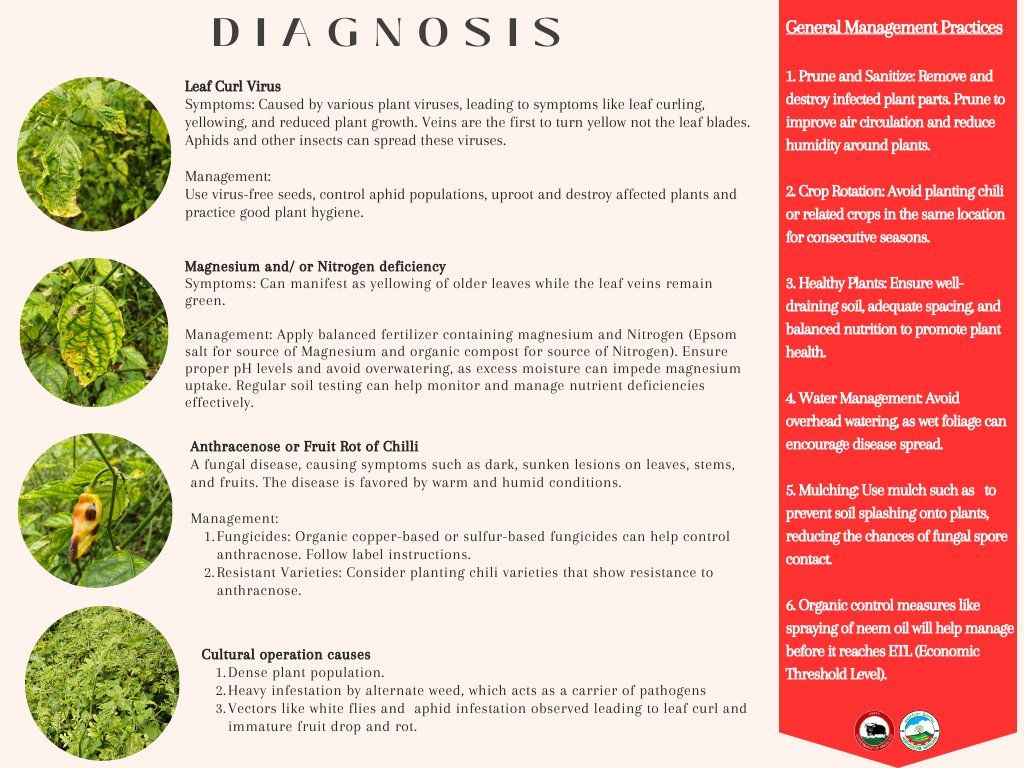Infestation of diseases in Naga Mircha in infestation of diseases in Naga Mircha. (Photo Courtesy: @horticulturengl/X)
.jpg)
Kohima, August 14 (MExN): The Horticulture Department Nagaland today informed that heavy infestation of diseases in Naga Mircha was reported from infestation of diseases in Naga Mircha.
Accordingly, the Department officers conducted an inspection in the village and offered diagnostic measures, it stated in an update on X (formerly Twitter).
The officers further urged all farmers to stay vigilant and adopt good management practices, it added.

Some of the diagnostic measures offered by the Department are:
Leaf Curl Virus
Symptoms: Caused by various plant viruses, leading to symptoms like leaf curling, yellowing, and reduced plant growth. Veins are the first to turn yellow not the leaf blades. Aphids and other insects can spread these viruses.
Management: Use virus-free seeds, control aphid populations, uproot and destroy affected plants and practice good plant hygiene.
Magnesium and/or Nitrogen Deficiency
Symptoms: Can manifest as yellowing of older leaves while the leaf veins remain green.
Management: Apply balanced fertilizer containing magnesium and Nitrogen (Epsom salt for source of Magnesium and organic compost for source of Nitrogen). Ensure proper pH levels and avoid overwatering, as excess moisture can impede magnesium uptake. Regular soil testing can help monitor and manage nutrient deficiencies effectively.
Anthracnose or Fruit Rot of Chilli:
A fungal disease, causing symptoms such as dark, sunken lesions on leaves, stems, and fruits. The disease is favoured by warm and humid conditions.
Management:
1. Fungicides: Organic copper-based or Sulfur-based fungicides can help control anthracnose. Follow label instructions.
2. Resistant Varieties: Consider planting chili varieties that show resistance to anthracnose.
Cultural operation causes
1. Dense plant population
2. Heavy infestation by alternate weed which act as a carrier of pathogens
3. Vectors infestation like white flies, aphid infestation observed leading to leaf curl and immature fruit drop and rot.
General Management Practice
1. Prune and Sanitise: Remove and destroy infected plant parts. Prune to improve circulation and reduce humidity around plants.
2. Crop Rotation: Avoid planting chili or related cropssame location for consecutive seasons
3. Healthy Plant: Ensure well-draining soil, adequate spacing, and balanced nutrition to promote plant health.
4. Water Management: Avoid overhead watering as wet foliage awl encourage disease spread.
5. Mulching: Use mulch such as to prevent soil splashing onto plants, reducing the chances of fungal spore contact.
6. Organic control measures like spraying of neem oil will help manage before it reaches ETL (Economic Threshold Level).



